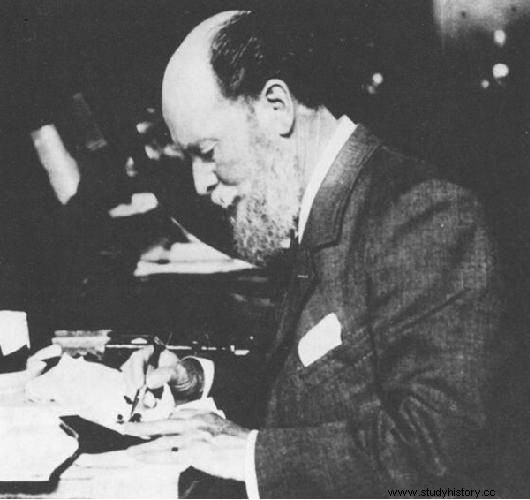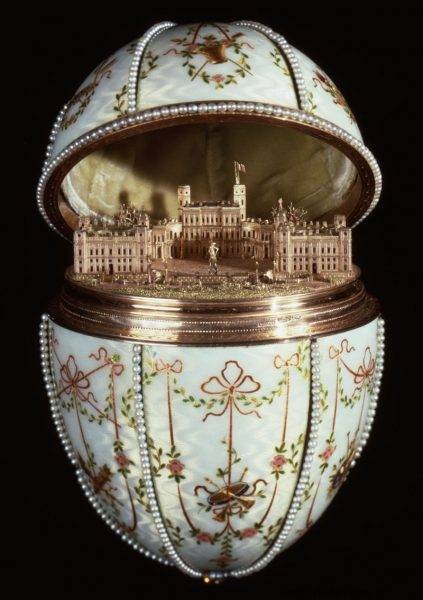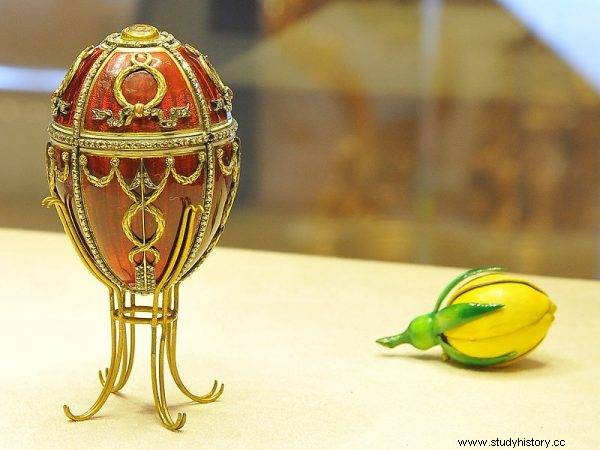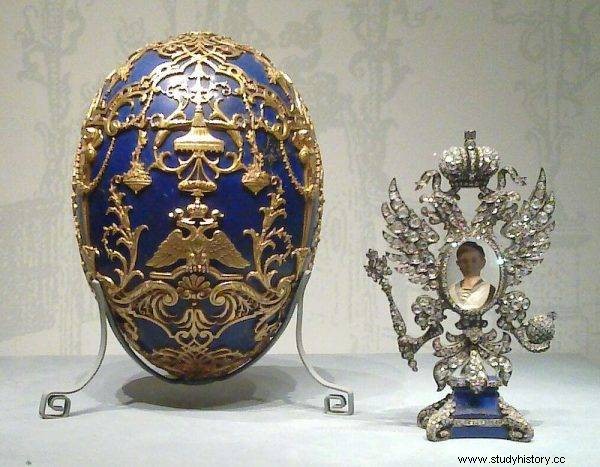Fabergé eggs are the most expensive Easter eggs in the world. Only a few dozen of them were created. Each of them is worth from several hundred thousand to even one hundred million dollars.
The famous Easter eggs were produced in the studio of the legendary Carl Fabergé, the tsarist jeweler, designer of precious trinkets, dishes, jewelry, trinkets and other whims of the pre-revolutionary Russian aristocracy. The Fabergé family was from France. She came from an old French Huguenot family. In 1685, she had to flee religious persecution. Initially, she settled in Estonia, which was then part of the Russian Empire. There, in Pärnu, Gustav Fabergé was born, who moved to Saint Petersburg with his wife Charlotte Jungstedt. In 1846 their son Carl Gustawowicz Fabergé was born - the future tsarist jeweler.
Luxury product
Four years before the birth of his son, Gustav Fabergé, he founded a small goldsmith's workshop in St. Petersburg. Carl was educated at a trade school in Dresden before following in his footsteps and taking over the family business. He learned the secrets of - today we would say - marketing. Then he visited Germany, France, Italy and England. In the meantime, learned the art of jewelery from respected goldsmiths, visited the most important European museums . In 1864 he returned to St. Petersburg and began working in his father's company. He was quickly promoted to manager and focused on modernizing the plant.

Carl Fabergé was a designer rather than a luxury product himself, but carefully checked each job.
He employed the best goldsmiths and focused on the production of luxury products, intricately made . The workshop produced snuffboxes, cigarette cases, boxes, mirrors, photo frames, figurines, vases, tableware, jewelry. Carl was a designer rather than a luxury product himself, but carefully checked each job. He was a perfectionist. He used to say that the value and craftsmanship should exceed the cost of the materials used. And it should be emphasized that the most expensive metals and the noblest stones were used in the Fabergé workshop. If Carl was not entirely satisfied, he would take a hammer and smash unsuccessful items to pieces.
A real breakthrough in the activities of Fabergé took place in 1882 during the Pan-Russian Industrial Exhibition in Moscow. Carl then received a gold medal for the products from his studio, which drew the attention of Empress Maria Fedorovna, wife of Alexander III. Three years later, Fabergé became the official tsarist jeweler. Soon after, the first famous egg was created.
Easter surprise egg
In Orthodox Russia, Easter was the most important holiday. At that time, they were gifted with decorated Easter eggs, symbolizing a new life. They were hand-painted in the countryside, porcelain was handed out in the city. Decorating eggs was believed to have a magical dimension, and meeting this condition will bring happiness.
In 1885, during the Easter season, it was the twentieth anniversary of the wedding of the tsarist couple . Tsar Alexander III wanted to give his wife a special gift. Through the intermediary of Grand Duke Włodzimierz Aleksandrowicz, he placed an order with Carl Fabergé. The jeweler then created the first imperial Easter gift in the form of an egg. The Tsarina received an apparently simple Easter egg, covered with white enamel, imitating a shell . It was opened with the hidden button. There was a surprise in the egg - a gold hen with ruby eyes, and inside it - a replica of the Tsar's crown set with diamonds and a small pendant with a ruby .

The tsarist family liked the Easter egg supplied by Carl so much that ordering them became an annual Easter tradition.
It was a real masterpiece of goldsmithing art. Maria Fedorovna was delighted with the original gift. Interestingly, Fabergé did not come up with the form of the gift himself. He was inspired by an egg from Rosenborg Castle in Copenhagen. Alexander III's wife was from Denmark, so the precious gift referred to her roots and was intended to resemble Christmas at home.
A priceless collection
The tsar's family liked the Easter egg supplied by Carl so much that ordering them became an annual Easter tradition. Tsar Alexander III gave his wife Fabergé eggs until his death in 1894. Each one was unique, taking up to two years to complete.
They were made of gold, silver, copper, nickel or palladium and decorated with precious stones, ivory and mother-of-pearl. They alluded to historical events and the life of the tsarist family such as the opening of the Trans-Siberian Railway or the coronation. They always contained a surprise inside, which remained a secret until the handing over. Even the Tsar did not know what would be in the egg. For example, in the third Easter egg in a row there is a Swiss watch by Vacheron Constantin, inlaid with precious stones.
Symbol of Tsarist Russia and the Romanov Dynasty
The tradition of handing Fabergé eggs was continued by the son of Alexander III - Nicholas II Aleksandrovich Romanov. Every year, the Tsar donated precious Easter eggs not only to his wife, Alexander Fedorovna, but also to his mother. After the wedding, Aleksandra got an egg decorated with ruby enamel and diamonds. Inside there is a yellow rose bud, which symbolizes nobility, and a ruby necklace inside it.
Between 1885 and 1917, Carl provided the 52 eggs to the Tsarist Dynasty . Easter eggs were not ordered due to the Russo-Japanese war in 1904–1905. Tsarina Maria received a total of 31 Easter gifts and Aleksandra - 21. One of the most famous is the "coronation" egg, referring to the coronation of Nicholas II and his wife. The design of the outer layer of the Easter egg was inspired by Alexandra's dress. Inside there is a faithful miniature copy of the golden coronation carriage. During its creation, all the details were taken care of. The seats are ruby, rock crystal, and there is a crown on the roof.

In 1885–1917, Carl delivered 52 eggs to the tsarist dynasty.
Eggs made by the Fabergé studio quickly gained fame and became a symbol of tsarist Russia and the Romanov dynasty. In 1900, they were presented at the World Exhibition in Paris, during which they won gold medals. Carl himself was then awarded the Legion of Honor, which made him recognizable in the international arena.
A toy for the rich
Rich aristocrats envied the tsarist family with their elaborate Easter gifts. Alexander Kelch, a millionaire owner of Siberian gold and platinum mines, ordered seven eggs from Fabergé's workshop for his wife Barbara, which were created between 1898 and 1904. Carl's company made eight more famous eggs including the Duchess of Marlborough, the Rothschild family, Emmanuel Nobel and Zinaida Yusupov, wife of Prince Felix Yusupov.
Fabergé has produced a total of 67 egg-shaped Easter gifts . Their further production was interrupted by the Bolshevik revolution. With its outbreak, Carl Fabergé was forced to close the company (and employed 700 workers at the time) and leave Russia. First he went to Germany, then to Switzerland, where he died two years later, in 1920.
Value of Fabergé eggs
The first egg with a chanterelle from 1885 cost about 4,151 rubles. It was a staggering sum, considering that a farm worker was earning more than one ruble a day at the time. Even a general with an annual salary of between two and four thousand rubles could not afford such a "trinket". The most expensive egg, made for Tsar Nicholas II, cost over 20,000 rubles. Fabergé products are currently at unbelievable prices. Some are valued at $ 30-50 million. The most valuable is the coronation egg, the value of which can reach up to $ 100 million.

Most of the imperial Fabergé eggs are in private and museum collections
Most of the imperial Fabergé eggs are in private and museum collections, including the museum of Russian billionaire Victor Vekselberg in St. Petersburg, the Kremlin Armory, the collection of Elizabeth II, and museums in New York, Washington, Richmond and Baltimore. Seven eggs are missing. Some may have been lost after the outbreak of the Bolshevik Revolution when the opponents of tsarism got rid of everything that they associated with the ruling dynasty. Later in the 1930s, Joseph Stalin sold fourteen eggs for just $ 400 each . Insiders say the lost Fabergé eggs may still be hiding somewhere waiting to be discovered.
Treasure from a flea market
In 2014, there was a lot of talk about an anonymous American scrap metal dealer who bought a small egg at an antiques market for $ 14,000. The American wanted to sell them or melt them down, but he failed to find a willing buyer. The trader decided to price the purchased item on his own. He simply entered "egg" and "Vacheron Constantin" in the search engine which is the words he found engraved on the watch inside the Easter egg. A moment later he found out that was the owner of the third tsarist egg from 1887 . He contacted a jewelry company, and they valued the precious gem at over $ 30 million . The egg has been sold to a private collector.
The art world has heard of many similar stories. Who knows what treasures can be hidden in attics, antique markets or antique stores.
